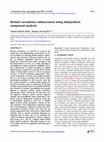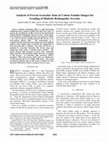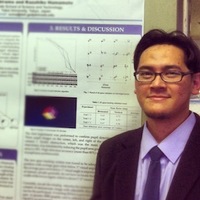Papers by Hanung Adi Nugroho

2015 International Conference on Data and Software Engineering (ICoDSE), 2015
Investigation of driver's physical fitness is an important research topic in accident prevention ... more Investigation of driver's physical fitness is an important research topic in accident prevention and intelligent driver monitoring system. Visual attention is one of physical fitness indicators that can be measured quantitatively. Driving simulator can be used to support observation of visual attention and behavior of the driver. On the other side, biomedical effect of driving simulator namely visually induced motion sickness (VIMS) is actively investigated to encourage appropriate usage of the simulator. However, there is no information on how sleep deprivation and day-night difference provoke VIMS and affect visual attention during simulation. In this paper, we present a novel investigation on effect of sleep deprivation and daynight difference on VIMS and visual attention using simulator sickness questionnaire (SSQ) and eye tracking. Statistical analysis on SSQ data shows that day-night difference and sleep deprivation induce symptoms of nausea (F(2,22)=5.825, p<0.05), oculomotor (F(2,22)=12.657, p<0.05), and disorientation (F(2,22)=8.270, p<0.05) significantly. Results of eye tracking analysis show that sleep deprivation and day-night difference affect visual attention significantly (F(2,22)=3.904, p<0.05). Experimental results suggest that driving simulation is better used in day-time to minimize VIMS. Furthermore, proper night rest beforehand and good room illumination are important to support physical fitness during day-time driving.
2015 International Conference on Science in Information Technology (ICSITech), 2015
2015 International Conference on Computer, Control, Informatics and its Applications (IC3INA), 2015
Abstract. In CT images, tumors located in a liver are generally identified by intensity differenc... more Abstract. In CT images, tumors located in a liver are generally identified by intensity difference between tumor and liver. The intensity of the tumor can be lower and or higher than that of the liver. However, the main problem of liver tumor detection from CT images is related to low contrast between tumor and liver intensities. Tumor sometimes presents in a very small dimension and makes the detection even more difficult.

Analyzing retinal fundus image is important for early detection of diseases related to the eye. H... more Analyzing retinal fundus image is important for early detection of diseases related to the eye. However, in fundus images the contrast between retinal blood vessels and the background is very low. Hence, analyzing or visualizing tiny blood vessels is difficult. Fluorescein angiogram overcomes this imaging problem but it is an invasive procedure that leads to other physiological problems. In this work, we enhance the low contrast of retinal vasculature in the ocular fundus image by determining the retinal pigments makeup, namely haemoglobin, melanin and macular pigment using independent component analysis. Independent component image due to haemoglobin pigment obtained exhibits higher contrast retinal vasculature. Even though the fundus fluorescein angiograph method produces higher contrast images, results show that this approach outperforms other noninvasive enhancement method, such as contrast limited adaptive histogram equalization and can be beneficial for vessel segmentation. Contrast enhancement factor of 3.2 for digital retinal images is achieved. This improvement in contrast reduces the need of applying contrasting agent on patients.

Early detection of several diseases related to the retina can be analyzed from fundus images. How... more Early detection of several diseases related to the retina can be analyzed from fundus images. However, in fundus images the contrast between retinal vasculature and the background is very low. Therefore, analyzing these tiny retinal blood vessels is difficult. Fluorescein angiogram overcomes this imaging problem; however, it is an invasive procedure that leads to other physiological problems. In this work, we develop a fundus image model based on probability distribution function of melanin, haemoglobin and macular pigment to represent melanin, retinal vasculature and macular region, respectively. Enhancement of the low contrast of retinal vasculature in the retinal fundus image is performed by separating the retinal pigments makeup, namely macular pigment, haemoglobin and melanin, using independent component analysis. Independent component image due to haemoglobin obtained exhibits higher contrast retinal blood vessels. Results show that this approach outperforms other non-invasive enhancement methods and can be beneficial for retinal vasculature segmentation. Contrast enhancement factor of 2.62 for a digital retinal fundus image model is achieved. This improvement in contrast reduces the need of applying contrasting agent on patients.
An enlargement of foveal avascular zone (FAZ) is usually found in eyes with diabetic retinopathy ... more An enlargement of foveal avascular zone (FAZ) is usually found in eyes with diabetic retinopathy (DR) resulting from a loss of capillaries in the perifoveal capillary network. Currently it is difficult to discern the FAZ area and to measure FAZ enlargement in an objective manner based on raw color fundus images.
Medical & Biological Engineering & Computing, 2011
Diabetic retinopathy (DR) is a sight threatening complication due to diabetes mellitus that affec... more Diabetic retinopathy (DR) is a sight threatening complication due to diabetes mellitus that affects the retina. In this article, a computerised DR grading system, which digitally analyses retinal fundus image, is used to measure foveal avascular zone. A v-fold cross-validation method is applied to the FINDeRS database to evaluate the performance of the DR system. It is shown that the system achieved sensitivity of [84%, specificity of [97% and accuracy of [95% for all DR stages. At high values of sensitivity ([95%), specificity ([97%) and accuracy ([98%) obtained for No DR and severe NPDR/PDR stages, the computerised DR grading system is suitable for early detection of DR and for effective treatment of severe cases.

Data from medical imaging system need to be analysed for diagnostics and clinical purposes. In a ... more Data from medical imaging system need to be analysed for diagnostics and clinical purposes. In a computerized system, the analysis normally involves classification process to determine disease and its condition. In an earlier work based on a database of 315 fundus images (FINDeRS), it is found that the foveal avascular zone (FAZ) enlargement strongly correlates with diabetic retinopathy (DR) progression having a correlation factor up to 0.883 at significant levels better than 0.01. However, it is also found that the FAZ areas can belong to different DR severity but with different levels of certainty having a Gaussian distribution. In this research work, the suitability of the Gaussian Bayes classifier in determining DR severity level is investigated. A v-fold cross-validation (VFCF) process is applied to the FINDeRS database to evaluate the performance of the classifier. It is shown that the classifier achieved sensitivity of >;84%, specificity of >;97% and accuracy of >;95% for all DR stages. At high values of sensitivity (>;95%), specificity (>;97%) and accuracy (>;98%) obtained for No DR and Severe NPDR/PDR stages, the Gaussian Bayes classifier is suitable as part of a computerised DR grading and monitoring system for early detection of DR and for effective treatment of severe cases.
Computers in Biology and Medicine, 2010
Monitoring FAZ area enlargement enables physicians to monitor progression of the DR. At present, ... more Monitoring FAZ area enlargement enables physicians to monitor progression of the DR. At present, it is difficult to discern the FAZ area and to measure its enlargement in an objective manner using digital fundus images. A semi-automated approach for determination of FAZ using color images has been developed. Here, a binary map of retinal blood vessels is computer generated from the digital fundus image to determine vessel ends and pathologies surrounding FAZ for area analysis. The proposed method is found to achieve accuracies from 66.67% to 98.69% compared to accuracies of 18.13–95.07% obtained by manual segmentation of FAZ regions from digital fundus images.
In the macular area, there are fovea and foveal avascular zone. Foveal avascular zone is the fove... more In the macular area, there are fovea and foveal avascular zone. Foveal avascular zone is the fovea devoid of capillaries. Enlargement of the foveal avascular zone is found to be related to the severity of diabetic retinopathy. Particular colours observed in the retinal image correspond to the optical properties of the pigments and the structure of the retinal layers. In this work, we use independent component analysis to determine retinal pigments from fundus images. The results show that independent component analysis can be used to ...

Journal of Biomedical Science and Engineering, 2009
Retinal vasculature is a network of vessels in the retinal layer. In ophthalmology, information o... more Retinal vasculature is a network of vessels in the retinal layer. In ophthalmology, information of retinal vasculature in analyzing fundus images is important for early detection of diseases related to the retina, e.g. diabetic retinopathy. However, in fundus images the contrast between retinal vasculature and the background is very low. As a result, analyzing or visualizing tiny retinal vasculature is difficult. Therefore, enhancement of retinal vasculature in digital fundus image is important to provide better visualization of retinal blood vessels as well as to increase accuracy of retinal vasculature segmentation. Fluorescein angiogram overcomes this imaging problem but it is an invasive procedure that leads to other physiological problems. In this research work, the low contrast problem of retinal fundus images obtained from fundus camera is addressed. We develop a fundus image model based on probability distribution function of melanin, haemoglobin and macular pigment to represent melanin, retinal vasculature and macular region, respectively. We determine retinal pigments makeup, namely macular pigment, melanin and haemoglobin using independent component analysis. Independent component image due to haemoglobin obtained is used since it exhibits higher contrast retinal vasculature. Contrast of retinal vasculature from independent component image due to haemoglobin is compared to those from other enhancement methods. Results show that this approach outperforms other non-invasive enhancement methods, such as contrast stretching, histogram equalization and CLAHE and can be beneficial for retinal vasculature segmentation. Contrast enhancement factor up to 2.62 for a digital retinal fundus image model is achieved. This improvement in contrast reduces the need of applying contrasting agent on patients.

Analyzing retinal fundus image is important for early detection of diseases related to the eye. H... more Analyzing retinal fundus image is important for early detection of diseases related to the eye. However, in fundus images the contrast between retinal blood vessels and the background is very low. Hence, analyzing or visualizing tiny blood vessels is difficult. Fluorescein angiogram overcomes this imaging problem but it is an invasive procedure that leads to other physiological problems. In this work, we enhance the low contrast of retinal vasculature in the ocular fundus image by determining the retinal pigments makeup, namely haemoglobin, melanin and macular pigment using independent component analysis. Independent component image due to haemoglobin pigment obtained exhibits higher contrast retinal vasculature. Even though the fundus fluorescein angiograph method produces higher contrast images, results show that this approach outperforms other noninvasive enhancement method, such as contrast limited adaptive histogram equalization and can be beneficial for vessel segmentation. Contrast enhancement factor of 3.2 for digital retinal images is achieved. This improvement in contrast reduces the need of applying contrasting agent on patients.
Characteristic of retinal vasculature has been an important indicator for many diseases such as h... more Characteristic of retinal vasculature has been an important indicator for many diseases such as hypertension and diabetes. A digital image analysis system can assist medical experts to make accurate diagnosis in an efficient manner. This paper presents the computer based approach to the automated segmentation of blood vessels in retinal images. The detection of the retinal vessel is achieved by performing image enhancement using CLAHE followed by Bottom-hat morphological transformation. Active contour model (snake) is then used to segment out the detected retinal vessel and produce a complete retinal vasculature. A Graphic User Interface (GUI) has also been created to ease the user for the segmentation of the retinal vasculature.

Early detection of several diseases related to the retina can be analyzed from fundus images. How... more Early detection of several diseases related to the retina can be analyzed from fundus images. However, in fundus images the contrast between retinal vasculature and the background is very low. Therefore, analyzing these tiny retinal blood vessels is difficult. Fluorescein angiogram overcomes this imaging problem; however, it is an invasive procedure that leads to other physiological problems. In this work, we develop a fundus image model based on probability distribution function of melanin, haemoglobin and macular pigment to represent melanin, retinal vasculature and macular region, respectively. Enhancement of the low contrast of retinal vasculature in the retinal fundus image is performed by separating the retinal pigments makeup, namely macular pigment, haemoglobin and melanin, using independent component analysis. Independent component image due to haemoglobin obtained exhibits higher contrast retinal blood vessels. Results show that this approach outperforms other non-invasive enhancement methods and can be beneficial for retinal vasculature segmentation. Contrast enhancement factor of 2.62 for a digital retinal fundus image model is achieved. This improvement in contrast reduces the need of applying contrasting agent on patients.

Diabetic retinopathy (DR) is a sight threatening complication due to diabetes mellitus that affec... more Diabetic retinopathy (DR) is a sight threatening complication due to diabetes mellitus that affects the retina. At present, the classification of DR is based on the International Clinical Diabetic Retinopathy Disease Severity. In this paper, FAZ enlargement with DR progression is investigated to enable a new and an effective grading protocol DR severity in an observational clinical study. The performance of a computerised DR monitoring and grading system that digitally analyses colour fundus image to measure the enlargement of FAZ and grade DR is evaluated. The range of FAZ area is optimised to accurately determine DR severity stage and progression stages using a Gaussian Bayes classifier. The system achieves high accuracies of above 96%, sensitivities higher than 88% and specificities higher than 96%, in grading of DR severity. In particular, high sensitivity (100%), specificity (>98%) and accuracy (99%) values are obtained for No DR (normal) and Severe NPDR/PDR stages. The system performance indicates that the DR system is suitable for early detection of DR and for effective treatment of severe cases.

Data from medical imaging system need to be analysed for diagnostics and clinical purposes. In a ... more Data from medical imaging system need to be analysed for diagnostics and clinical purposes. In a computerized system, the analysis normally involves classification process to determine disease and its condition. In an earlier work based on a database of 315 fundus images (FINDeRS), it is found that the foveal avascular zone (FAZ) enlargement strongly correlates with diabetic retinopathy (DR) progression having a correlation factor up to 0.883 at significant levels better than 0.01. However, it is also found that the FAZ areas can belong to different DR severity but with different levels of certainty having a Gaussian distribution. In this research work, the suitability of the Gaussian Bayes classifier in determining DR severity level is investigated. A v-fold cross-validation (VFCF) process is applied to the FINDeRS database to evaluate the performance of the classifier. It is shown that the classifier achieved sensitivity of >;84%, specificity of >;97% and accuracy of >;95% for all DR stages. At high values of sensitivity (>;95%), specificity (>;97%) and accuracy (>;98%) obtained for No DR and Severe NPDR/PDR stages, the Gaussian Bayes classifier is suitable as part of a computerised DR grading and monitoring system for early detection of DR and for effective treatment of severe cases.
At present, it is difficult to determine Foveal Avascular Zone (FAZ) enlargement based on colour ... more At present, it is difficult to determine Foveal Avascular Zone (FAZ) enlargement based on colour fundus images. Fundus image analysis presents several challenges such as high image variability, improper illumination and artifacts. A new approach for grading Diabetic Retinopathy (DR) by analysing FAZ enlargement in colour fundus image has been developed. Investigations show that FAZ area ranges can be used to indicate progression of the disease. The mean accuracy and standard deviation of ranges obtained are 92.2% and 3.22, respectively. This new approach is reliable, accurate and fast compared to the current method based on DR pathologies.
An enlargement of foveal avascular zone (FAZ) is usually found in eyes with diabetic retinopathy ... more An enlargement of foveal avascular zone (FAZ) is usually found in eyes with diabetic retinopathy (DR). Currently, it is difficult to discern the FAZ area and to measure its enlargement in an objective manner using on colour fundus.
Diabetic retinopathy (DR) is a sight threatening complication due to diabetes mellitus that affec... more Diabetic retinopathy (DR) is a sight threatening complication due to diabetes mellitus that affects the retina. In this article, a computerised DR grading system, which digitally analyses retinal fundus image, is used to measure foveal avascular zone. A v-fold cross-validation method is applied to the FINDeRS database to evaluate the performance of the DR system. It is shown that the system achieved sensitivity of >84%, specificity of >97% and accuracy of >95% for all DR stages. At high values of sensitivity (>95%), specificity (>97%) and accuracy (>98%) obtained for No DR and severe NPDR/PDR stages, the computerised DR grading system is suitable for early detection of DR and for effective treatment of severe cases.









Uploads
Papers by Hanung Adi Nugroho